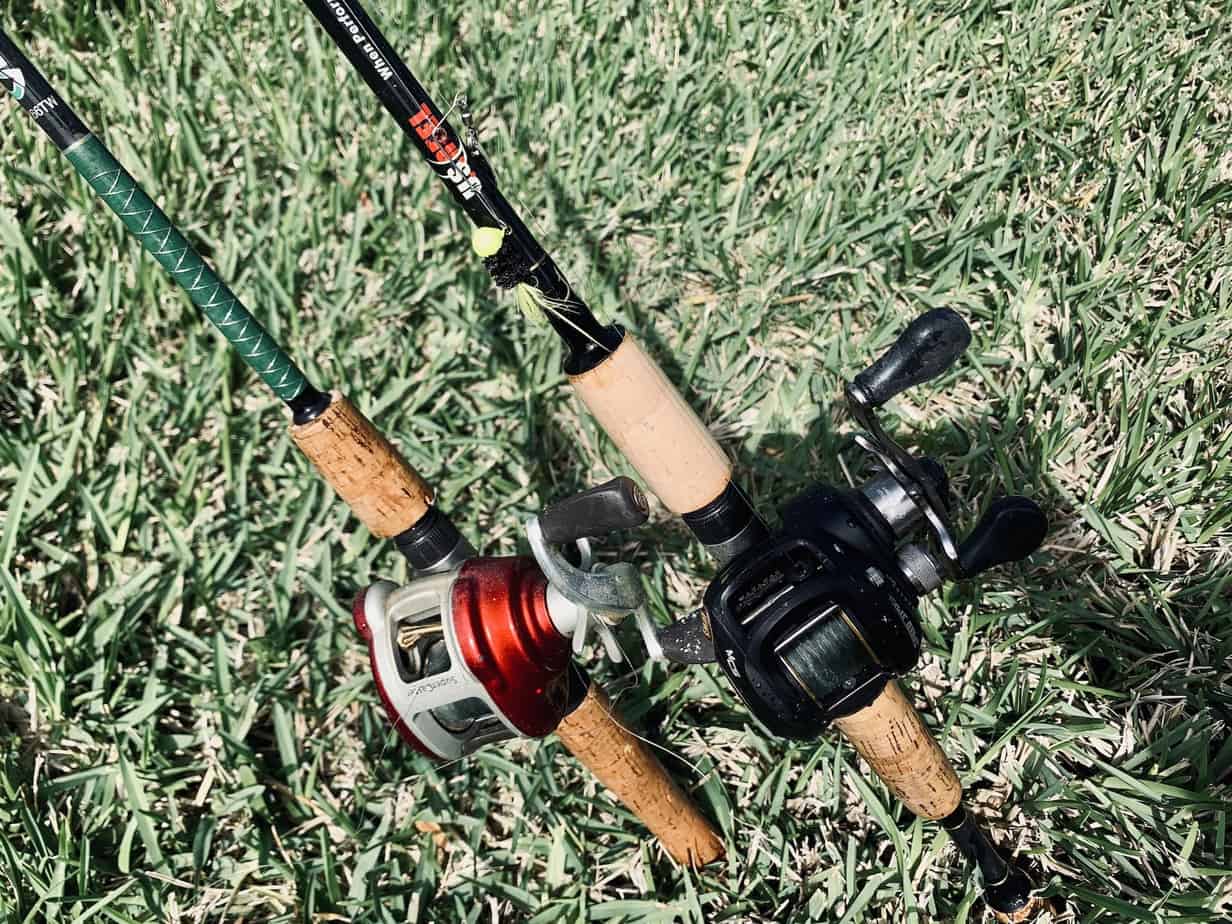Baitcasting reels are commonly used for freshwater bass fishing, but are also used inshore in saltwater for certain applications. The person who is looking to use a baitcasting setup in saltwater is commonly coming from freshwater fishing or is someone looking to experiment with a new fishing method. Baitcasting is a completely different technique than casting with spinning tackle, so it can be a new challenge for anglers to learn to cast with a baitcaster. This article will cover low profile baitcasters with shorter rods which will be best used for inshore fishing or hitting nearshore troughs on the beach. To read about the workhorse round-style baitcasters for long casts from the beach, read our article here.
From the perspective of freshwater anglers, baitcasters can be perceived as the superior reel because it is a true challenge to learn to cast them without getting the dreaded birds nest. Spinning reels generally handle light lures better, but if you’re using medium sized lures and looking for accurate casts, a baitcaster is right for you. Baitcasters also have the advantage of being lightweight and paired with smaller rods which can make them a great choice for Stand-Up Paddleboard fishing (SUP fishing). If you’re interested in reading more about different types of fishing reels, read our article Understanding the Differences Between Types of Fishing Reels.
Rod & Reel Combo #1:
Rod: Star Stellar Lite 6’6” casting rod $110
Star rods are best known around Florida, but they’re becoming much more well known around the country. The Star Stellar Lite series comes in spinning and casting configurations and are a great lightweight inshore rod. For pairing with a baitcasting reel, I would go for the 6’6” Heavy Power Star Stellar Lite casting rod (model # PG1525ISS). I would most likely be using 20 lb test mono for my inshore fishing and 20 lb test falls right in the middle of the line rating range of 15-25 lbs. The lure weight rating is ½ oz to 2 ½ oz, which lets me use almost all of my inshore lures. This rod has a trigger grip which I like for more support when using a baitcasting reel. The butt is 11 inches long and a full grip. I prefer the full grip over a split grip option so I can put my hands wherever I want. This rod runs about $110 which is a great, affordable price point for an inshore casting rod.
Reel: Daiwa Coastal TW Baitcasting Reels $240
The Daiwa Coastal TWS wins for the saltwater baitcasting reel from Daiwa. The Coastal TW has fantastic features for the price, including 7+1 Corrosion Resistant Ball Bearings (CRBBs), the T Wing System (TWS), Magforce Z cast control and Ultimate Tournament Drag.
When it comes to ball bearings, the Coastal’s 7+1 Corrosion Resistant Ball Bearings (CRBBs) are better than the mixture of 2 CRBBs and 5 ball bearings like you see in the Daiwa Tatula or the Daiwa Coastal SV reel. The CRBBs seal out sand, dust and salt to provide 12 times the corrosion resistance of regular ball bearings. Fishing in saltwater is the harshest environment you can put reels through and Daiwa has taken major steps to provide protection from the elements to extend the life of your reel. When it comes to reel maintenance, it’s helpful to know the location of the bearings, so I included a diagram with them pointed out below.
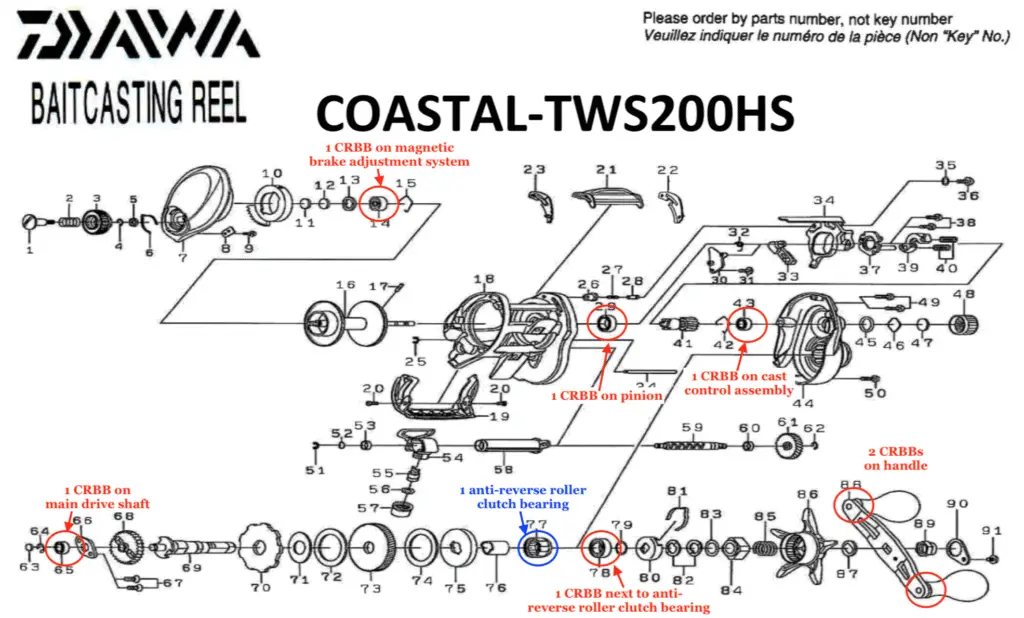
The T Wing System (TWS) is a “T” shaped levelwind. When the clutch is depressed during casting, the hood lifts, allowing the line to move into the horizontal section of the T. In this section, the line can move freely within that width. This decreases the friction during a cast which improves casting distances. During the retrieve, the hood lowers and moves the line into in the vertical part of the “T” to accurately perform levelwinding. See the diagram below for a pictorial representation of the TWS.
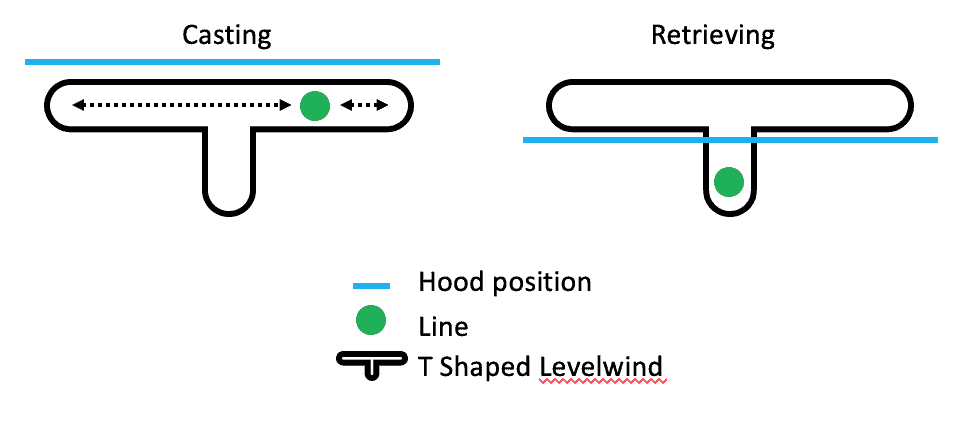
This reel also includes the Magforce Z cast control technology which is Daiwa’s second generation of magnetic drag. It originally came out in 2007 and helps improve casting distance by regulating the amount of brakes during the release. At the beginning of the cast, the inductor is disengaged from the magnets and allows the line to freespool out, then as the spool RPMs increase, the inductor engages into the magnets to provide braking to prevent a backlash. At the end of the cast, when the RPMs of the spool decrease, the inductor disengages and the line is in freespool again.
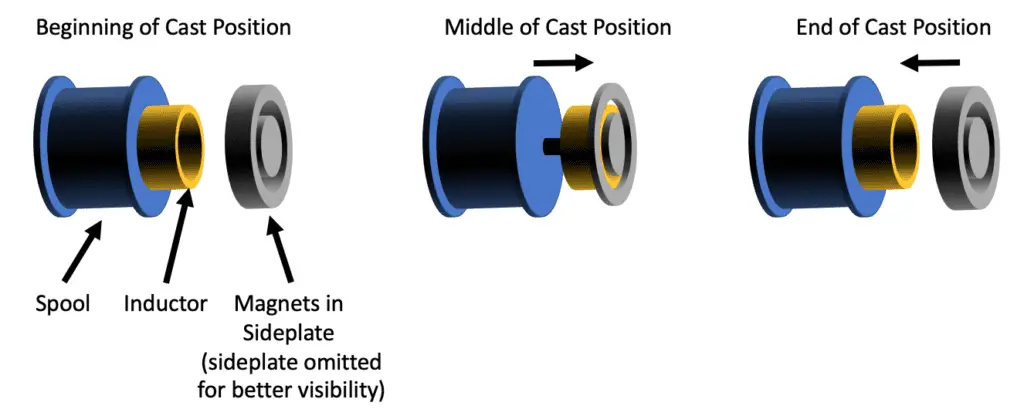
The brake sensitivity can also be set tighter or looser by the angler. For starters, I would recommend tying on your lure, depress the clutch and set it so that the lure falls lightly on its own. Then you can go one click tighter and that should be a good starting point. If you end up getting backlash, try another click tighter. Preventing backlash takes some practice, and it might not always be a cast control setting that needs to change. It might also be thumbing that’s needed. Remember that setting the brake sensitivity is about striking the balance between too light brake causing backlash and too much brake causing a reduction in casting distance.
Daiwa’s Ultimate Tournament Drag (UTD) is in this reel. The UTD is a smooth and powerful drag, but doesn’t engage until a certain force is exerted on it. To an experienced fisherman, this can feel unsmooth at the moment the drag engages, but then works smoothly after that. As you search for the Daiwa Coastal TWS, be careful not to confuse it reel with the Coastal SV TW which is marketed for saltwater but is lacking corrosion resistant ball bearings and Ultimate Tournament Drag. For help choosing a saltwater lure, head on over to our article, 9 Best Saltwater Topwater Lures (including Size & Color).
Rod & Reel Combo #2:
Rod: Shimano Teramar XX Casting Rod $303
The Shimano Teramar XX collection has regional versions. You can find Southeast, Southwest, West Coast and Northeast. Each version was designed with the fish species common to those regional waters and built with consideration of the techniques commonly used in the region, so choose the one appropriate for your location. Although there are differences between the regional versions of this rod, the construction is consistent among all of them, and the construction is what sets this rod apart.
The older Teramar model was built with TC4 construction and the new Teramar XX is higher performing with its Spiral X and Hi Power X construction. The construction consists of 3 layers: 1 layer of carbon fiber tape (Infinity Tape) wrapped diagonally along the blank, 1 layer of a carbon fiber sheet with vertically oriented fibers, and another layer of Infinity Tape wrapped diagonally along the blank in the opposite direction of the first layer, forming an X shape, hence the name Spiral X. The spiral gives it superior torsional rigidity so the rod doesn’t wobble when casted. Without any wobble, your cast is more powerful and accurate. The Spiral X technology also gives improves the strength of the rod, while also decreasing the weight.
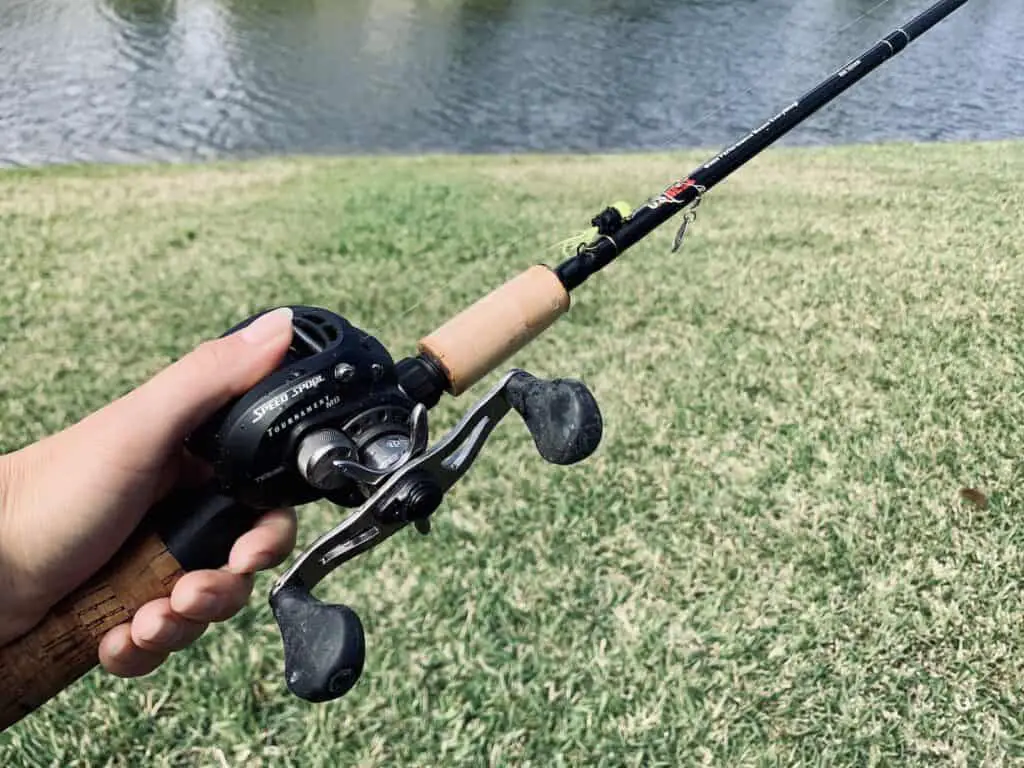
The rod is strong enough to handle heavy lures with minimal recoil and the sensitive enough to clearly feel the bites. This rod comes in a casting and a spinning version, but we’re recommending the casting version here since we’re pairing it with a baitcasting reel.
The model numbers are descriptive for these rods. For example, the Southeast 7’ Casting rod with Medium Heavy power, and Extra fast action is TXECX70MH where TX represents Teramar XX, E represents Southeast, C represents casting, X represents extra fast action, 70 represents the length in feet and inches, 7ft 0inches, and MH represents Medium Heavy power. Where E represents Southeast, you can also find N for Northeast, W for West Coast, and S for Southwest. Where C represents casting, you can also find S for spinning. If the X is absent, the action is anything but extra fast. For the power rating, you’ll see M for Medium, MH for Medium Heavy, ML for Medium Light, and H for heavy power. I use this rod mostly for inshore casting on the Florida East coast and I went with the TXECX70MH 7’ Medium Heavy power, Extra Fast action. Line weight rating is 15-40 lb, and lure weight ½-1.5 oz, making this a versatile rod.
Reel: Shimano Curado DC 150 $260 (NEW in 2022: Curado DC 200)
The Shimano Curado DC is an incredible product with its digital braking system. The system senses the speed of the spool at 1/1000th of a second and sends the info to the internal microcomputer. The microcomputer will then pulse the brakes at just the right amount to prevent birds nests. With conventional braking systems, your thumb would be doing most of the spool speed regulation, which makes baitcasting reels sometimes difficult and frustrating to learn. It also takes experience to learn the right amount of pressure to put on the spool with any given lure or weather conditions.
The digital braking system of the Curado DC makes it so a new baitcaster could go an entire day without getting a birds nest. This microcomputer is in an entirely sealed area of the reel, so saltwater won’t affect its performance.
The Curado DC 150 is a very small, low profile reel. It’s very comfortable in your hand for palming and lightweight for repeated use all day. The line capacity on the reel is enough for inshore saltwater fishing for medium sized fish, without being big and bulky. It holds 150 yards of 20 lb braid, 135 yards of 30 lb braid, and 105 yards of 40 lb braid. For monofilament, the capacity is 120 yards of 10 lb mono, 110 yards of 12 lb mono and 90 yards of 14 lb mono. I’d recommend using mono with your baitcasting reels since braid is nearly impossible to untangle if you get a bird’s nest. If this line capacity seems a little low for you, the size 200 might suit you better. It was freshly launched at ICAST 2022.
On the reel, you can set the sensitivity of the brakes. There is an open setting, and settings 1-4. Open is used when you want to remove the side plate for servicing. Setting 1 is for long distance casting as it has the lightest brake sensitivity. Setting 4 is meant for high wind conditions, short casts, and/or light lures. Settings 2 and 3 are meant for conditions and lures that fall between those two boundaries. The braking is intended to work without needing any thumbing at all, but thumbing won’t hurt it either if you choose to do it. The ease of use of this reel makes it enjoyable for the novice angler, the lifetime angler, and everyone in between.
You can also adjust the cast control. This is something you’ll need to play with as you get experience with the reel, but a good starting point is to adjust the dial when the lure is on the line, right at the rod tip, and set the cast control just tight enough that the lure doesn’t fall. When the cast control is set tight, it’s harder for the line to flow freely from the spool. When the cast control is set lightly, it’s easier for the line to flow freely from the spool. The line flow is also affected by the weight of your lure, which is why this is an important setting to check every time you switch lures.
For corrosion resistance, the reel uses Shielded Anti-Rust Bearings (S-ARB) which are the same as the ARB ball bearings with additional shields on either side to prevent salt or other corrosion causing substances from getting in the bearing. The ball bearings are protected from the harsh salt environment, making the durability of this reel great, even in saltwater. The 11 lbs of max drag is plenty for most inshore species in Florida.
There are 3 different gear ratios you can choose from. The 6.2:1 (model number CUDC150 or 151) has a 26 inch crank rate and 7.8 oz weight, the High Gear ratio 7.4:1(model number CUDC150HG or 151HG) has a 31 inch crank rate and 7.8 oz weight, and the Extra High Gear ratio of 8.5:1 pulls in 36 inches of line per crank at a weight of 7.9 ounces. The line capacity is the same on all 3 versions, so choose the gear ratio and crank rate you like best. If you’re trying to fight some bigger fish, you should go with the lowest gear ratio (model number CUDC150 or 151) because the larger gear teeth have more power to fight the big fish. I chose the high gear ratio for myself since I'll most often be using this reel from my paddleboard and targeting smaller fish, but I wanted it to be able to handle a larger one when the time comes.
I mostly do inshore fishing on the east coast of Florida so I pair the CUDC150HG with the Shimano Teramar XX Southeast casting rod.
If you ever have any issues with a part inside the reel, you can go to Shimano’s website, on a page like this, and order the part and replace it yourself. Before doing this, I would caution you to take a look at the schematic and make sure you understand it and are up for the challenge of taking it apart and putting it back together. The schematic also mentions that spool clutch pin and the roller clutch bearing cannot be replaced by the customer and you’ll need to reach out to Shimano’s after-sales service if there’s an issue. There are 6+1 bearings on the Shimano Curado DC. This means there are 6 ball bearings and 1 roller bearing. Let’s take a look at the reel schematic for the left hand retrieve high gear version of the Curado DC to see where the bearings are (schematic comes from Shimano’s website):
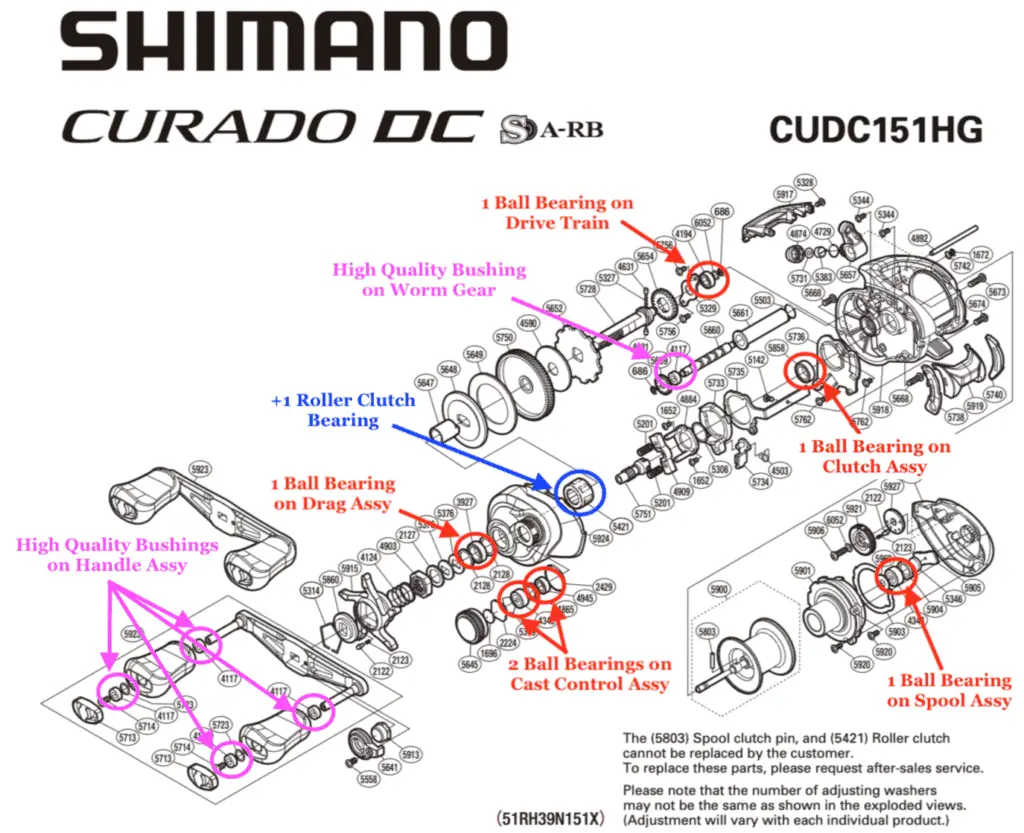
The 6 ball bearings are pointed out in red. The “+1” indicating a roller bearing, is identified in blue. I also went ahead and pointed out where Shimano uses high quality bushings instead of bearings in purple. Sometimes you’ll see companies market reels as better or smoother because of the high bearing count, however usually when they do this, they’re adding ball bearings to the areas pointed out in purple, the worm gear or the handles. It's a marketing technique instead of an actual performance advantage to have bearings in those locations. Shimano typically opts for high quality bushings in those locations and they have a history of performing very well.
The Shimano Curado DC rings in at $260, which is the mid price range for reels. It is a great value for your money considering the technology that’s in the digital braking system. Most of the time, the only complaint we hear about this reel is that we don’t own enough of them!
Reel Comparison: Shimano Curado DC vs Daiwa Coastal TWS specs
| Mono Capacity | Weight | Max Drag | Gear Ratio | Retrieve Rate | Price | |
| Daiwa Coastal TWS | 165 yds 14 lb | 8.1 oz | 15.4 lbs | 7.3:1 | 32.2 in | $239.99 |
| Shimano Curado DC (HG version) | 90 yds 14 lb | 7.8 oz | 11 lbs | 7.4:1 | 31 in | $259.99 |
The two reels recommended in this article have some differing specs that might help you decide which one is better for your needs. Daiwa typically prioritizes line capacity moreso than Shimano, and you can see that here with a 165 yard capacity in the Coastal TWS vs a 90 yard capacity for 14 lb monofilament in the Shimano Curado. Its important to realize the targeted application for using these reels. Since you’re pairing with shorter rods, you’re unlikely to be long casting and so 90 yard capacity should be plenty. If you end up catching a big fish with the Curado, you might need to start thumbing it if your drag is engaged and you want to be cautious about the line you have left. With the Daiwa Coastal TWS, you probably wouldn’t worry about line length at all.
As far as the max drag, both of them have sufficient drag, but the Coastal TWS would be able to let a larger fish run more than a Curado DC. More likely though, you’re going to be targeting snook or a medium sized redfish in the mangroves and you’ll just crank down the drag and pull the fish out of the mangroves. A drag of 11 lbs is enough to do this, and your line is unlikely to break if you’re using 20 lb monofilament.
The gear ratios and retrieve rates of these two reels are pretty comparable. The Shimano Curado DC is about 3 tenths of an ounce lighter which might be important for you if you plan on casting for hours on end. The price difference is about $20, which generally isn’t going to drive your decision between the two. You could be like me and order one of each!
I hope this article was helpful. While you’re here, check out our article on Light Tackle Fishing – Rods, Reels, Lines and Lures. Tight lines, y’all!
Recent Posts
Fat Cow Jig Strips: The Ultimate Bucktail Jig Upgrade for Surf Fishing
As discussed in my previous article, "Surf Fishing with Bucktail Jigs: Ultimate Guide for Beach Anglers," bucktail jigs are a staple in any surf angler's tackle box, offering a versatile way to catch...
In my previous article, "Surf Fishing with Bucktail Jigs: Ultimate Guide for Beach Anglers," I introduced you to the bucktail jig and discussed how versatile of a lure it is for catching a wide range...

